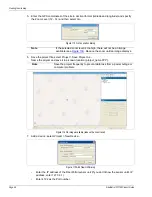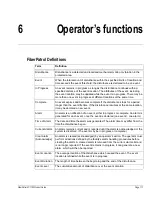
Setting Alarm Detection Parameters
Page 108
FiberPatrol FP1150 Product Guide
Rather than striking the fence, you can also simulate a cut intrusion by weaving a length of fence
wire tightly into the panel and then cutting the inserted wire. Both methods generate a signal that is
similar to the response of an actual cut intrusion. An actual fence cut also creates a significant
amount of secondary fence noise as the cut section of wire pulls apart.
Simulated climb intrusion tests
For a simulated climb intrusion, the best method is to actually climb the fence. It is not necessary
to climb over the fence. The tester simply needs to climb on the fence for as long as it takes to
generate an alarm (typically less than 3 seconds).
If climbing on the fence is not possible, dragging a screwdriver across the surface of the fence can
be used as a climb simulation. Place the blade of a screwdriver against the fence fabric and drag
the screwdriver across the fence panel while applying light pressure.
Buried cable intrusion tests
To simulate third party interference (TPI) dig in the soil above the sensor cable for at least 10
seconds. (Use caution during the digging activity to prevent damaging the sensor cable.
For above ground intrusion simulation, beginning about 5 m (16 ft.) away from the sensor cable
walk across the cable path at a normal pace.
For tunneling detection use a hammer to repeatedly strike a 1/2 in. steel plate that is placed on the
ground directly above the sensor cable.
Setting the full cable Sensitivity Thresholds
The full cable Sensitivity Thresholds are software settings that control the sensitivity of the entire
sensor. When correctly set, the full cable Sensitivity Thresholds make the FP1150 sensor sensitive
enough to detect an intruder, while keeping nuisance alarms to a minimum. The following
procedure requires two people.
1.
Go to the Signal sub-panel.
2.
Set the Disturbance Life to 15 seconds, and the Event Life to 60 seconds.
3.
Have a test subject go to a straight section of the perimeter (away from any cable loops,
corners, and gates), and simulate an intrusion.
4.
On the FiberPatrol sensor unit, access the Signal sub-panel and observe the Disturbance
display and Alarm status. Note the magnitude of the disturbance, and how quickly the gray
bars turned to red (signaling an alarm). Repeat the intrusion test five times to determine how a
typical intrusion appears on the display.
5.
Raise the Disturbance Threshold and Alarm Threshold and repeat the intrusion tests, so that
the test subject always generates an alarm during the tests at the highest possible threshold
settings. If raising the thresholds results in a failed test (no alarm) lower the threshold
accordingly.
Note
Conduct an initial climb intrusion test to determine how long it takes to
generate an alarm at your site.
CAUTION
Use protective gloves and suitable footwear during the climb intrusion
testing.
Note
Remove any potential sources of vibrations from the vicinity of the sensor
cable.
















































